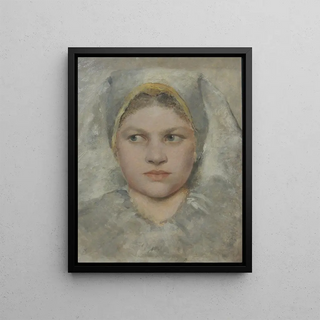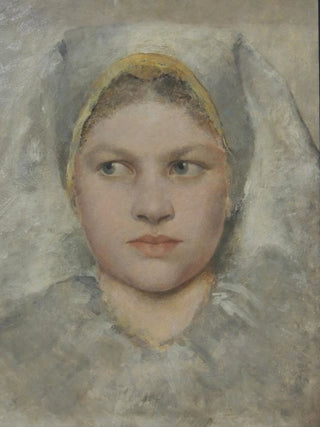Art print | Head study of a girl by Hana - Gustav Klimt


View from behind

Frame (optional)
Gustav Klimt's "Study of a Girl's Head of Hana" is a true ode to feminine beauty and sensitivity. This artwork, rooted in the Symbolist movement, reveals the artist's fascination with delicate faces and subtle expressions. Klimt, renowned for his ability to blend sensuality and spirituality, invites us to delve into the intimacy of his model. The composition of this study, though seemingly simple, evokes an emotional depth that captivates the viewer. The art print of this piece allows for a rediscovery of Klimt's fascinating universe, while adding a touch of elegance to any interior.
Style and uniqueness of the work
The originality of "Study of a Girl's Head of Hana" lies in its treatment of the face and hair of the young girl. Through flowing lines and warm colors, Klimt succeeds in capturing light in a way that brings his model to life. The details of the hair, carefully crafted, almost seem to dance around the face, adding a vibrant dynamism to the piece. This study, far from being a simple sketch, reveals impressive technical mastery, where each brushstroke is loaded with meaning. The color palette, soft and harmonious, helps create an atmosphere that is both serene and enchanting. Klimt thus manages to transcend mere representation to offer a poetic vision of femininity.
The artist and his influence
Gustav Klimt, an emblematic figure of the Vienna Secession, is recognized not only for his distinctive style but also for his influence on modern art. His ability to fuse decorative art and figurative painting paved the way for many contemporary artists. Klimt explored themes such as love, death, and beauty, while incorporating symbolic elements that provoke thought and fascination. His unique approach to color and texture has inspired generations of artists, redefining aesthetic conventions of his time. Through works like "Study of a Girl's Head of Hana," he reminds us of the importance of sensitivity and emotion in art, making him a pioneer whose

Matte finish

View from behind

Frame (optional)
Gustav Klimt's "Study of a Girl's Head of Hana" is a true ode to feminine beauty and sensitivity. This artwork, rooted in the Symbolist movement, reveals the artist's fascination with delicate faces and subtle expressions. Klimt, renowned for his ability to blend sensuality and spirituality, invites us to delve into the intimacy of his model. The composition of this study, though seemingly simple, evokes an emotional depth that captivates the viewer. The art print of this piece allows for a rediscovery of Klimt's fascinating universe, while adding a touch of elegance to any interior.
Style and uniqueness of the work
The originality of "Study of a Girl's Head of Hana" lies in its treatment of the face and hair of the young girl. Through flowing lines and warm colors, Klimt succeeds in capturing light in a way that brings his model to life. The details of the hair, carefully crafted, almost seem to dance around the face, adding a vibrant dynamism to the piece. This study, far from being a simple sketch, reveals impressive technical mastery, where each brushstroke is loaded with meaning. The color palette, soft and harmonious, helps create an atmosphere that is both serene and enchanting. Klimt thus manages to transcend mere representation to offer a poetic vision of femininity.
The artist and his influence
Gustav Klimt, an emblematic figure of the Vienna Secession, is recognized not only for his distinctive style but also for his influence on modern art. His ability to fuse decorative art and figurative painting paved the way for many contemporary artists. Klimt explored themes such as love, death, and beauty, while incorporating symbolic elements that provoke thought and fascination. His unique approach to color and texture has inspired generations of artists, redefining aesthetic conventions of his time. Through works like "Study of a Girl's Head of Hana," he reminds us of the importance of sensitivity and emotion in art, making him a pioneer whose






